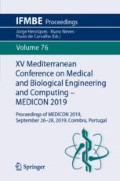Abstract
Pulse Transition Time (PTT) is being increasingly used for estimating blood pressure unobtrusively aiming at continuous assessment of cardiovascular diseases (CVD) and illness monitoring using portable and low-cost equipment. Several methods are available for PTT estimation, each one accepting its own constraints and physical parameters’ assumptions, besides the panoply of definitions attributed to PTT calculus. Defining PTT as the time difference between the time instant were peak R occurred in an electrocardiogram (ECG) cardiac cycle and the time instant were the photoplestimography (PPG) signal of correspondent cardiac cycle presents the inflexion point of its maximum slope, a method of PTT estimation based on measured ECG and PPG signals during several cardiac cycles is proposed. This method was tested on ECG and PPG data collected from 7 individuals for periods ranging from 30 min to 8 h. For the sake of PTT algorithm performance evaluation, ECG and PPG signals were collected with a commercial system, together with the PTT signals provided by the same equipment resultant from automatic computation with unknown algorithm. Preliminary results so far obtained encourage the use of the proposed PTT estimation algorithm on future internet of things (IoT) e-health system development aiming at elderly blood pressure estimation and CVD assessment. Accuracy of the proposed algorithm (0.9 correlation with reference signal) may be improved by further studies on raw data filtering parametrizations.
Access this chapter
Tax calculation will be finalised at checkout
Purchases are for personal use only
References
WHO. https://www.who.int/cardiovascular_diseases/en/. Accessed 12 March 2019
Chow, C.K., et al.: Prevalence, awareness, treatment, and control of hypertension in rural and urban communities in high-, middle-, and low-income countries. JAMA 310, 959–968 (2013)
Parati, G., et al.: Assessment and management of blood-pressure variability. Nat. Ver. Cardiol. 10, 143–155 (2013)
Pinheiro, N., et al.: Can PPG be used for HRV analysis? In: Conference of the Proceedings IEEE Engineering in Medicine and Biology Society, pp. 2945–2949, IEEE, Orlando (2016). https://doi.org/10.1109/embc.2016.7591347
Schäfer, A., Vagedes, J.: How accurate is pulse rate variability as an estimate of heart rate variability?: a review on studies comparing photoplethysmographic technology with an electrocardiogram. Int. J. Cardiol. 166(1), 15–29 (2013)
Ding, X.-R., et al.: Continuous blood pressure measurement from invasive to unobtrusive. IEEE J. Biomed. Health Inf. 20, 1455–1465 (2016)
Ding, X.-R., et al.: Pulse transit time based continuous cuffless blood pressure estimation: a new extension and a comprehensive evaluation. Sci. Rep. 7, 11554 (2017). https://doi.org/10.1038/s41598-017-11507-3
Ullah, K., et al.: Effective ways to use internet of things in the field of medical and smart health care. In: Proceedings of ICISE. IEEE (2016). https://doi.org/10.1109/intelse.2016.7475151
Alberto, M.C. et al.: Sensory system for the sleep disorders detection in the geriatric population. In: Proceedings Experiment@ Conference, Faro, Portugal (2017). https://doi.org/10.1109/expat.2017.7984384
Zhou, X., et al.: Validation of new and existing decision rules for estimation of beat-to-beat pulse transit time. BioMed Res. Int. (2015). https://doi.org/10.1155/2015/306934
Allen, J.: Photoplethysmography and its application in clinical physiological measurement. Physiol. Meas. 28(3), R1–R39 (2007)
Velzen, M.H., et al.: Increasing accuracy of pulse transit time measurements by automated elimination of distorted photoplethysmography waves. Med. Biol. Eng. Comput. 55, 1989–2000 (2017). https://doi.org/10.1007/s11517-017-1642-x
Carek, A.M., Inan, O.T.: Robust sensing of distal pulse waveforms on a modified weighting scale for ubiquitous pulse transit time measurement. IEEE Trans. Biomed. Circ. Syst. 11(4), 765–772 (2017)
Somnomedicis. https://somnomedics.eu/products/cardiology/24h-bloodpressure-24h-ecg/somnotouch-nibp/. Assessed 12 March 2019
Gutiérrez-Rivas, R., et al.: Novel real-time low-complexity QRS complex detector based on adaptive thresholding. IEEE Sens. J. 15(10), 6036–6043 (2015)
Chatterjee, S.: Time domain analysis of heart rate variability – an attempt towards characterization of trends. IJETSR 4(1), 41–49 (2017)
Conde, C.A.: Heart rate variability parameters and the PNNX family as discriminators between athletes and sedentary people. JPES 16(4), 1316–1325 (2016)
Acknowledgements
Authors would like to thank Fundação para a Ciência e Tecnologia grants SFRH/BSAB/142998/2018 and SFRH/BSAB/142997/2018, Junta de Comunidades de Castilla La Mancha for supporting this work (FrailCheck project SBPLY/17/180501/000392) and the medical doctors from Guadalajara Hospital that are collaborating in this study.
Author information
Authors and Affiliations
Corresponding author
Editor information
Editors and Affiliations
Ethics declarations
There is no conflict of interest.
Rights and permissions
Copyright information
© 2020 Springer Nature Switzerland AG
About this paper
Cite this paper
Ruano, M.G., Fazel, A.S., Martín, A.J., Ruano, A., Domínguez, J.J.G. (2020). Pulse Transition Time Method for Unobtrusive Blood Pressure Estimation. In: Henriques, J., Neves, N., de Carvalho, P. (eds) XV Mediterranean Conference on Medical and Biological Engineering and Computing – MEDICON 2019. MEDICON 2019. IFMBE Proceedings, vol 76. Springer, Cham. https://doi.org/10.1007/978-3-030-31635-8_183
Download citation
DOI: https://doi.org/10.1007/978-3-030-31635-8_183
Published:
Publisher Name: Springer, Cham
Print ISBN: 978-3-030-31634-1
Online ISBN: 978-3-030-31635-8
eBook Packages: EngineeringEngineering (R0)

